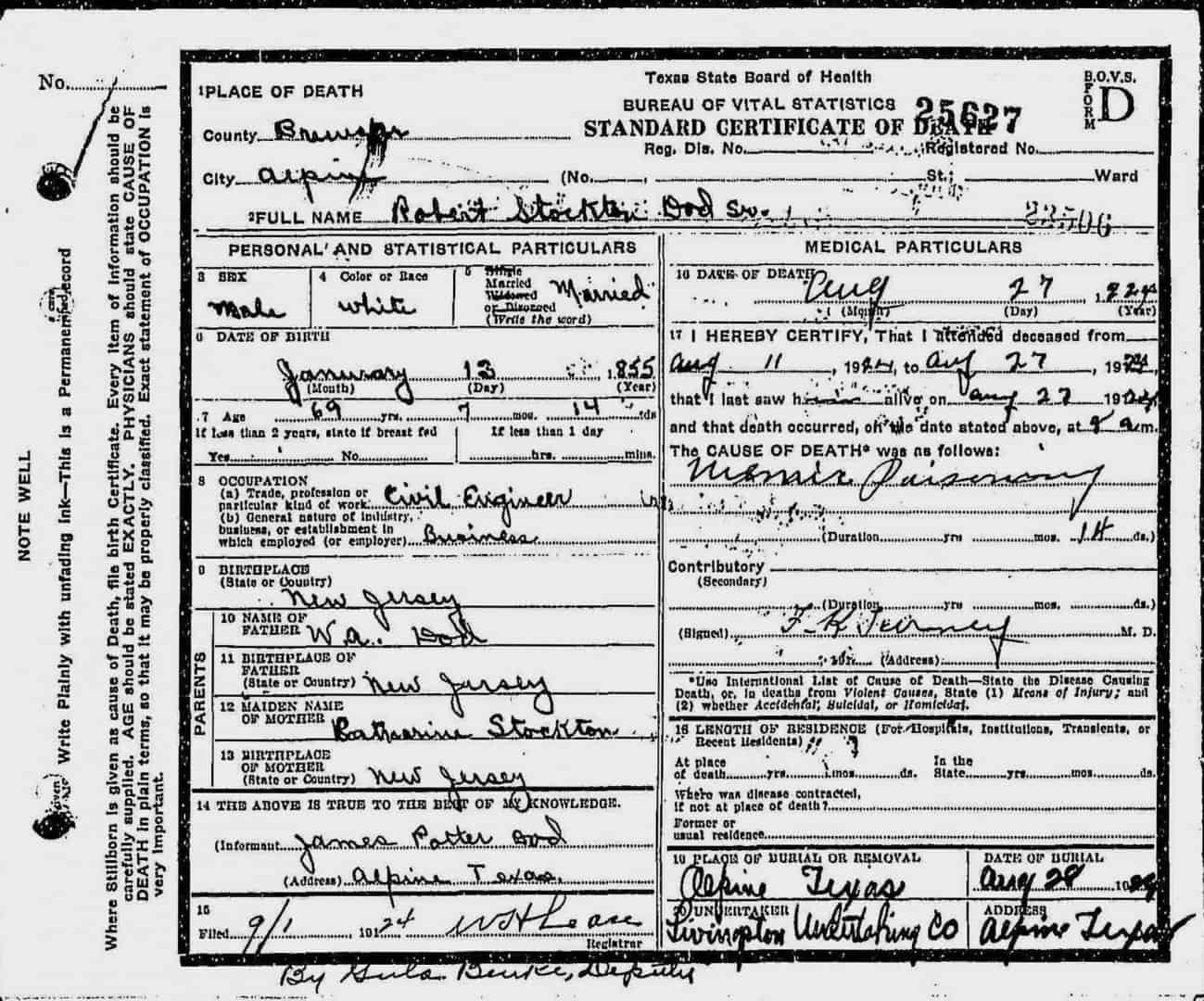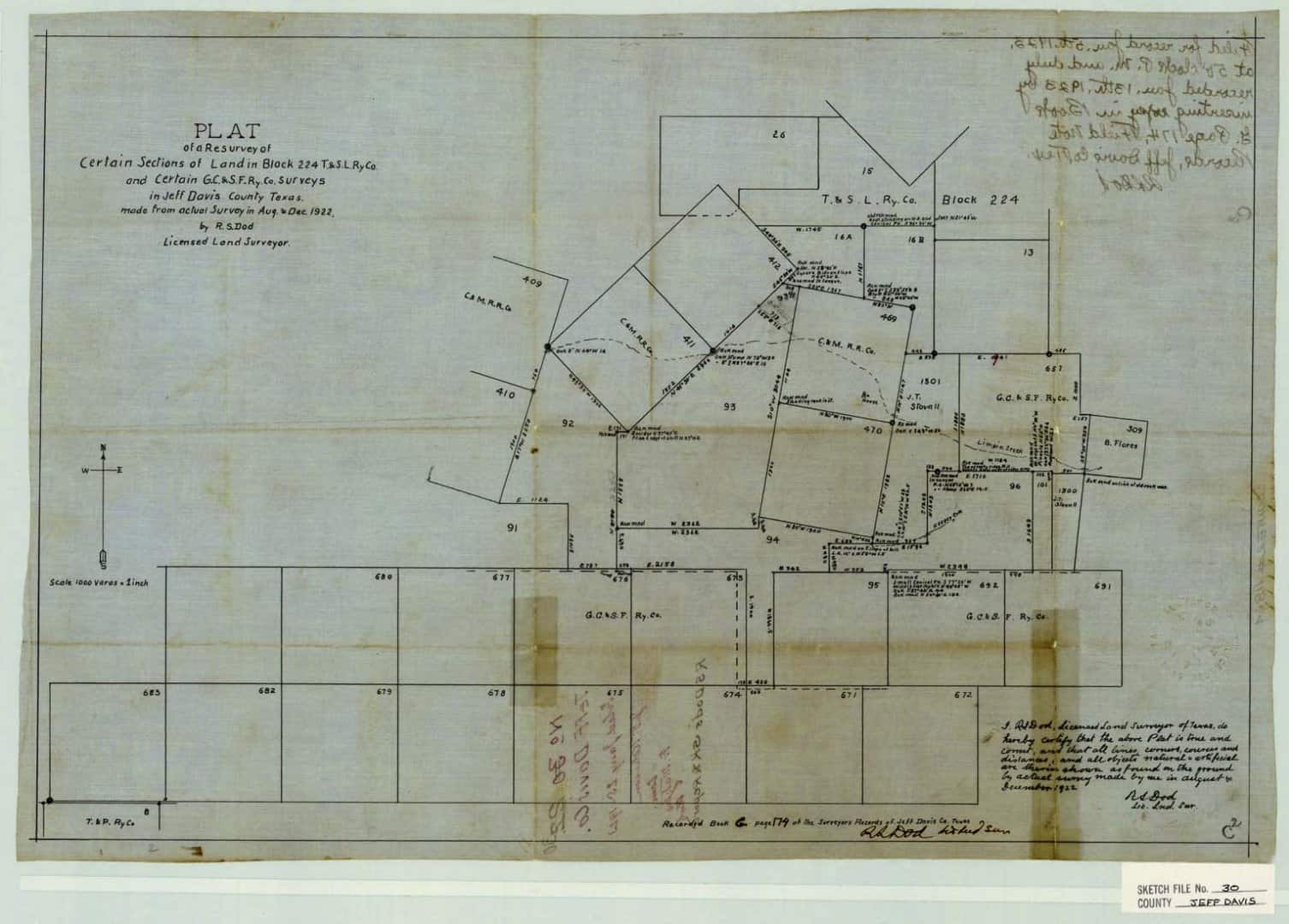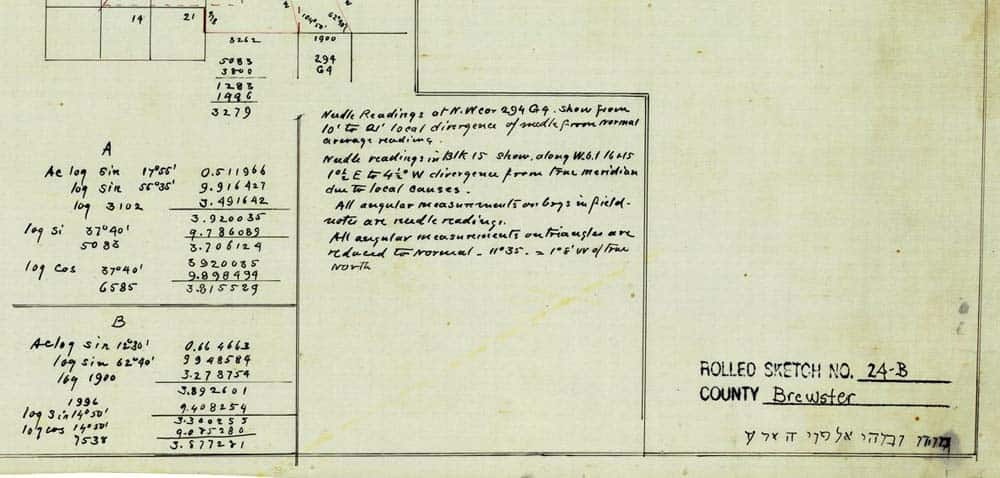I guess eventually the internet will know every secret, but for now I'm a bit surprised to be putting together a few of the pieces of the career of Robert S. Dod, a prominent West Texas Surveyor who worked in the Big Bend area in the first two decades of the 20th century. He is the tall, gaunt figure on the left, holding a stadia board in the photo above. Mr. Dod began his career as a Texas surveyor by a route that is no longer recommended.
He was born in Princeton, Mercer County, New Jersey on January 13, 1855, the son of William Armstrong Dod, an Episcopalian minister, and Catherine Elizabeth (Stockton) Dod. The 1860 census indicates that the Dods were well-to-do, with a personal estate valued at about $12,000, most of that sum evidently being from Mrs. Dod for whom by1870 the census reported her personal estate to be $34,000 and that of her husband, the Reverend Dod, only $1500.
At the time of the 1870 census, when Robert was 15, he was reported to be a college student, then a freshman at the College of New Jersey in Princeton, living with his 43-year-old mother and 54-year-old father at their home in Princeton, New Jersey. He had progressed to being a Junior at the same college in 1871, and a senior in 1872, still living at home. At the age of about 18 in 1873, Robert Stockton Dod graduated with honors from the College of New Jersey.
In December of 1874, the nineteen-year-old Robert S. Dod's passport application reported that he was 6 ft. 1 in. tall, with a high forehead, hazel eyes and a straight nose of medium size above a medium-sized mouth over a round chin on an oval face. His hair was then dark brown and his complexion "dark". Evidently Dod traveled abroad after graduation.
By 1876, he was a member of the junior class at the General Theological Seminary of the Protestant Episcopal Church in the US as a "Candidate for Orders in the Diocese of New Jersey". Following graduation from Seminary, Robert S. Dod lived in New York City from roughly 1880 through 1884 as an Episcopal priest ministering to the poor at the Holy Cross Mission on the lower East Side. A 1884 City Directory of New York City reported Rev. Robert S. Dod residing at 330 E. 13th Street. By one account, Dod and two other priests lived a nearly monastic existence from which Dod eventually withdrew and ended up in Texas.
The interesting question is what Robert Stockton Dod did with himself between about 1884 and August of 1892. That later date was when R.S. Dod was in Brady, Texas according to the application that he made to F.M. Carroll, then County Surveyor of McCulloch County, an office that by January of the next year Dod himself held. Papers he filed in the Texas General Land Office as McCulloch County Surveyor show that Mr. Dod remained in that office at least through 1899, along the way marrying Ida Viola Harcourt, the seventeen-year-old daughter of the District Clerk in 1894.
Judging by the filings that R.S. Dod made in the Texas General Land Office as Mcculloch County Surveyor, evidently the Dods remained in McCulloch County at least until 1903 when they moved to San Antonio before another move in 1906 to Alpine where their seventh child was born and where Mr. Dod was eventually buried after his death in 1924 at age 69 from causes that his death certificate lists as "McNair Poisoning" as nearly as I can make out. I believe that means that Robert Stockton Dod died from the toxic effect of poison ivy that entered his system in some form. Considering that West Texas is hardly overrun by poison ivy, that in itself is a remarkable detail.
Here is an image of that Death Certificate in case anyone can see a more likely transcription than "McNair Poisoning".
My Father was a Civil Engineer first, then an Episcopalian Priest later.
The typical practice here was the Surveyors would put their name prominently on the map with the initials C.E. or Civil Engineer and State Licensed Land Surveyor under the signature line of the certificate (much less prominent). Then they all could become licensed Civil Engineers when the first P.E. Act was passed in 1930.
Blue linen and a crows foot pen and a myriad of transparencies and carbons to copy letters.
All that makes my fingers tired quickly.
So glad that all I have to do is fiddle with a keyboard, load some paper and ink, select the number to output and click on print.
Dave Karoly, post: 395968, member: 94 wrote: The typical practice here was the Surveyors would put their name prominently on the map with the initials C.E. or Civil Engineer and State Licensed Land Surveyor under the signature line of the certificate (much less prominent). Then they all could become licensed Civil Engineers when the first P.E. Act was passed in 1930.
R.S. Dod was actually a decent surveyor for the time and place he worked. As far as I know, nearly all of his rural surveys were run with transit and statia and so the distances aren't always any better than you would expect for stadia measurements over five or six hundred feet.
The "State Land Surveyor" was a license that the oil boom created when the County Surveyors were overrun with demands for surveys that only the County Surveyor or his deputies were authorized to make. In Dod's report, the "Mr. Merrill" he refers to was a landowner who had himself been County Surveyor, more by default than ability, as Dod discovered when he tested a supposed corner pointed out to him by Merrill.
I'm guessing poison oak is more common than poison ivy in Texas, but the effects are basically the same.
It's all about the urushiol.
AJF
There is a reference to a J.B. McNair who apparently studied Rhus Poisoning (e.g. Poison Ivy, Poison Oak, and Poison Sumac) in the November 1916 Journal of the American Medical Association. It doesn't say anything about dying from it though.
sicilian cowboy, post: 396028, member: 705 wrote: I'm guessing poison oak is more common than poison ivy in Texas, but the effects are basically the same. It's all about the urushiol.
AJF
Angelo, I'd forgetten about the Davis Mountains which rise above a Chihuahuan desert landscape that I don't think would support either poison ivy or poison oak. Poison ivy is reportedly present among the plants that do grow in the Davis Mountains where the higher altitude creates a little island of higher rainfall. That may well be where Mr. Dod was exposed to it.
Dave Karoly, post: 396030, member: 94 wrote: There is a reference to a J.B. McNair who apparently studied Rhus Poisoning (e.g. Poison Ivy, Poison Oak, and Poison Sumac) in the November 1916 Journal of the American Medical Association. It doesn't say anything about dying from it though.
There apparently are some people who are hyper-sensitive to urushiol. I't possible, I suppose, that was why Mr. Dod moved to the West Texas desert in the first place.
I had pulled together some files for Dod on Ancestry.com last year when I was messing with some tracts down near Terlingua. Not sure if Ancestry.com shares those links with you. I notice that he may have or had a son or grandson in Marfa. I am curious if any of his instruments or files remain with the family but I've never attempted to find out.
Andy Nold, post: 396035, member: 7 wrote: I had pulled together some files for Dod on Ancestry.com last year when I was messing with some tracts down near Terlingua. Not sure if Ancestry.com shares those links with you. I notice that he may have or had a son or grandson in Marfa. I am curious if any of his instruments or files remain with the family but I've never attempted to find out.
One of his sons was James Potter Dod, better known as J.P. Dod, a Licensed State Land Surveyor. J.P. inherited the R.S. Dod papers and the records of both went to Steve Walker in Alpine who had them when I last saw them and made copies of some of them.
Andy Nold, post: 396035, member: 7 wrote: I had pulled together some files for Dod on Ancestry.com last year when I was messing with some tracts down near Terlingua. Not sure if Ancestry.com shares those links with you.
If there is anything on ancestry.com about the years between R.S. Dod's departure from the Episcopal clergy sometime after 1884 and his marriage to the seventeen-year-old girl in 1894 when he was forty, I missed it. It's a strange transition and I wonder how it happened.
Here is a link to the Episcopal Church site on him:
http://www.episcopalchurch.org/library/glossary/dod-robert-stockton
He founded the Order of the Holy Cross.
Dave Karoly, post: 396067, member: 94 wrote: Here is a link to the Episcopal Church site on him:
http://www.episcopalchurch.org/library/glossary/dod-robert-stocktonHe founded the Order of the Holy Cross.
Those are some interesting details about the early part of Dod's religious career through age 30; Quoting from your link:
"(Jan. 13, 1855-Aug. 27, 1924). One of three founders of the Order of the Holy Cross. He studied at General Theological Seminary. Dod was ordained deacon on June 9, 1878, and priest on Aug. 24, 1880. He and James Otis Sargent Huntington attended a retreat in Philadelphia on Nov. 8-13, 1880, led by the Rev. William John Knox-Little, a leading English ritualist. Here they decided to form an American religious order for men. Dod then went to England where he was received as a postulant of the Society of St. John the Evangelist at Cowley on Feb. 1, 1881. In Apr. 1881, he left Cowley and went to the Mother House of St. John the Baptist at Clewer, Windsor. At Clewer, Dod wrote the preliminary notes for the rule and constitution of the proposed order. On Aug. 27, 1881, Dod returned to the United States. On Oct. 1, 1881, he and Huntington moved into the first house of the Order of the Holy Cross. Dod served as superior of the developing order. The Order of the Holy Cross was officially formed on Nov. 25, 1884, when Huntington took his vows. Dod never made a monastic profession, but Huntington called him the "founding father" of the order. He lived much of the rest of his life as an invalid. Dod died in Alpine, Texas."
I wonder what the nature of his infirmity was that didn't keep him from making extensive surveys in the desert areas of West Texas. Could have been tuberculosis, I suppose.
By the way, knowing that R.S. Dod had made a serious study of theology in an Episcopalian seminary in the 1880s fits one odd piece of his later surveying career into the perspective of his life. In 1910, Mr. Dod worked as a State Surveyor in the Big Bend's Brewster County trying to figure out where one particular block of surveys known as Block G-4 was located on the ground. One of the preliminary sketches he filed has a notation in Hebrew in the margin of the lower right-hand corner that looks like this:
In 1989, GLO staff went to the trouble to have the notation translated, thinking it might offer some revealing clue. A faculty member at UT returned the following English translation of Mr. Dod's Hebrew phrase : "There was chaos upon the face of the Earth."
Kent McMillan, post: 396074, member: 3 wrote: ..I wonder what the nature of his infirmity was that didn't keep him from making extensive surveys in the desert areas of West Texas. Could have been tuberculosis, I suppose.
One of the ways that contact dermatitis can become systemic is through smoke inhalation of the burning vegetation such as poison oak or ivy. If Dod lived with tuberculosis (a lot of folks did back then) and had the bad luck of sucking the smoke from burning poison oak, the end could have been described as "McNair poisoning". But that's just a guess. I have far too active an imagination to get into guessing...;)
paden cash, post: 396097, member: 20 wrote: One of the ways that contact dermatitis can become systemic is through smoke inhalation of the burning vegetation such as poison oak or ivy. If Dod lived with tuberculosis (a lot of folks did back then) and had the bad luck of sucking the smoke from burning poison oak, the end could have been described as "McNair poisoning".
Yes, I thought about that, but had a hard time imagining how Dod could have encountered burning poison ivy in the vicinity of Alpine where he lived. It grows in the Davis Mountains, probably in very few better-watered locations in canyons and draws. I personally can't recall ever having seen poison ivy anywhere in Jeff Davis, Brewster, or Presidio Counties, but the botanists who inventoried the native plants of Jeff Davis list Poison Ivy, so it probably is there somewhere.
Again, what about poison oak? And what about the possibility that his exposure was not limited to west Texas. As I recall from my research, Dod moved to West Texas to "seek out drier climes" because of his health issues (which I read as tuberculosis or other similar). But surely in his day and age he could easily hop a train to Austin or other areas where he could be exposed to urushiol.
Kent McMillan, post: 395966, member: 3 wrote: Mr. Dod was active in land surveying practically until his death in 1924 as the report below he filed in the Texas GLO in 1923 about some work he had done in the Davis Mountains indicates.
Yes
The Stockton name is a very prominent in NJ history.
Robert Hill, post: 396116, member: 378 wrote: Yes
The Stockton name is a very prominent in NJ history.
Dod's mother was Catharine Elizabeth Stockton b. 03/19/1827 Charleston, S.C. d. 03/24/1874, the daughter of Harriet Maria (Potter) Stockton and Commodore Robert Field Stockton.







